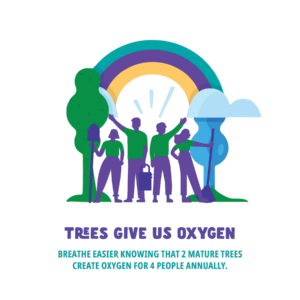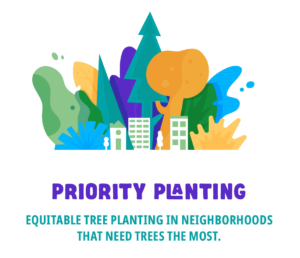Category: The Friends of Trees Way
Trees Fight Climate Change

Tree planting ‘has mind-blowing potential’ to tackle climate crisis.
Damian Carrington, The Guardian
What Technology Could Reduce Heat Deaths? Trees.
At a time when climate change is making heat waves more frequent and more severe, trees are stationary superheroes: They can lower urban temperatures 10 lifesaving degrees, scientists say.
Einhorn, The New York Times, July 2021
“At a time when climate change is making heat waves more frequent and more severe, trees are stationary superheroes. Research shows that heat already kills more people in the United States than hurricanes, tornadoes and other weather-events, perhaps contributing to 12,000 deaths per year. Extreme heat this week in the Pacific Northwest and Canada has killed hundreds.
“Trees can lower air temperature in city neighborhoods 10 lifesaving degrees, scientists have found. They also reduce electricity demand for air conditioning, not only sparing money and emissions, but helping avoid potentially catastrophic power failures during heat waves.” (from The New York Times, read the entire article here)
From the Arbor Day Foundation: Through the natural process of photosynthesis, trees absorb CO2 and other pollutant particulates, then store the carbon and emit pure oxygen – and greener communities are cooler communities.
Friends of Trees content about trees’ superhero abilities to fight climate change, and related projects and programs.
Dr. Vivek Shandas and FOT’s former Deputy Director Whitney Dorer take a tree walk after the summer 2021 heat dome event and talk about trees and climate change:
Trees Absorb Carbon

Trees are without a doubt the best carbon capture technology in the world.
“When they perform photosynthesis, they pull carbon dioxide out of the air, bind it up in sugar, and release oxygen. Trees use sugar to build wood, branches, and roots. Wood is an incredible carbon sink because it is made entirely of carbon, it lasts for years as a standing tree, and takes years to break down after the tree dies. While trees mainly store carbon, they do release some carbon, such as when their leaves decompose, or their roots burn sugar to capture nutrients and water.
“Let’s look at a real example, a white oak can live for 200 years; all that time it is pulling carbon out of the air and storing it. After several anthracnose outbreaks the tree dies, but it takes decades for the tree to rot. While it is slowly breaking down, the rotten tree is still keeping carbon out of the atmosphere.”
From How Forests Store Carbon, Norman and Krye, PennState Extension, 2020. Read the entire article here.
Trees Keep Us Cool

Trees can lower air temperature in city neighborhoods 10 lifesaving degrees, scientists have found.
“At a time when climate change is making heat waves more frequent and more severe, trees are stationary superheroes. Research shows that heat already kills more people in the United States than hurricanes, tornadoes and other weather-events, perhaps contributing to 12,000 deaths per year. Extreme heat this week in the Pacific Northwest and Canada has killed hundreds.
“Trees can lower air temperature in city neighborhoods 10 lifesaving degrees, scientists have found. They also reduce electricity demand for air conditioning, not only sparing money and emissions, but helping avoid potentially catastrophic power failures during heat waves.”
From What Technology Could Reduce Heat Deaths? Trees. Einhorn, The New York Times, 2021. Read the entire article here.
Dr. Vivek Shandas demonstrates the temperature difference when trees are present, joined by FOT’s Whitney Dorer:
Trees Give Us Oxygen

The Power of One Tree – The Very Air We Breathe
“A tree has the ability to provide an essential of life for all living things on our planet – oxygen, and the power to remove harmful gases like carbon dioxide making the air we breathe healthier.
“Here is how it works: To keep it simple a tree is comprised of its leaves, stems, trunk and its roots. When you look at a tree, note that about five percent of the tree is comprised of its leaves, 15 percent its stems, 60 percent goes into its truck and 20 percent is devoted to its roots.
“Here is the super hero part. Through a process called photosynthesis, leaves pull in carbon dioxide and water and use the energy of the sun to convert this into chemical compounds such as sugars that feed the tree. But as a by-product of that chemical reaction oxygen is produced and released by the tree. It is proposed that one large tree can provide a day’s supply of oxygen for up to four people.”
Excerpted from The Power of One Tree – The Very Air We Breathe, Stancil, U.S. Forest Service, 2015
Priority Planting

Friends of Trees recognizes that not everyone has equal access to the benefit of trees.
Friends of Trees will always strive to be a welcoming and safe place for everyone, regardless of age, ability, race, religion, sexual orientation, gender identity, political views or economic status. Without our volunteers, we are nothing. But together we do amazing things.
This statement is included at the beginning of all Friends of Trees public planting events
As a community driven organization we foster an atmosphere of inclusion and support, and we strive to build places that are safer and healthy for all. We accomplish this through authentic community conversation; unique partnerships; relevant programming; and attracting and retaining diverse staff and supporters.
Friends of Trees’ Equity and Diversity Inclusion Committee is a standing committee comprised of board and staff who recommend readings and workshops, organize trainings, and review our programs and materials through an equity lens. We use deliberate outreach and communication strategies toward engaging a diverse range of volunteers and tree-recipients. Our board of directors identifies as 55% BIPOC and 66% women; our staff identifies as 53% BIPOC; 50% women; 43% men; 3% gender queer; 3% non-binary.
Community planting goes beyond getting trees in the ground. Friends of Trees’ programs engages volunteers of all ages, races, religions, sexual orientation, gender identity, economic status, and political views to plant and care for trees together. Our programming cultivates partnerships that center climate justice and engages people from historically underserved communities to directly play a part in improving the health and livability of their neighborhoods. We administer environmental education and internships that expand opportunities to enter the green workforce. Authentically engaging communities is crucial toward achieving climate justice.
Read a variety of articles about how we work to deliver programming that is equitable and inclusive.
